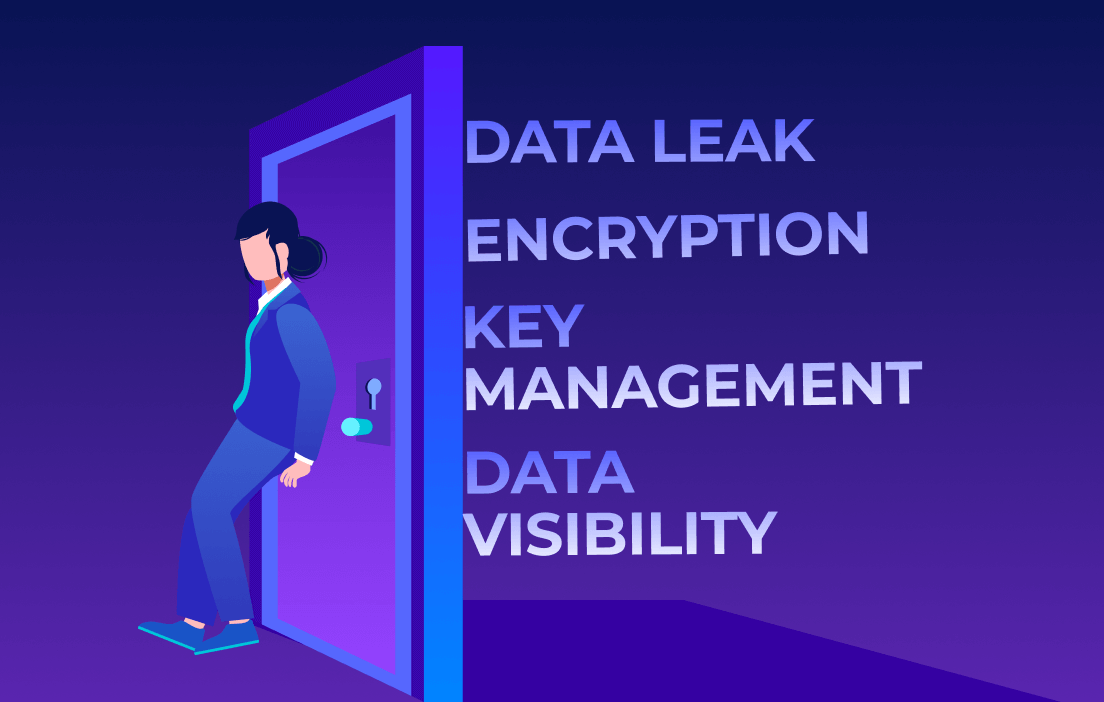Implementation of Cloud computing has transformed how businesses store, manage, and access data. However, with the increasing reliance on cloud technology comes potential data security challenges in cloud computing.
According to the Cost of a Data Breach 2022 Report, the average cost of a data breach globally was $4.35 million in 2022, representing a 2.6% increase from 2021, when the average cost was $4.24 million.
As data breaches become more frequent and costly, organizations must have more visibility into the problems surrounding cloud data security.
This blog explains data security challenges and its solution in cloud computing to help organizations protect their sensitive information.
Here are the most common cloud data security challenges:
1. Lack of Data Visibility
For obvious reasons, organizations need an overview of what is happening with their data in the cloud. For example, a cloud infrastructure functions in a multi-tenant environment, which means too many users are accessing data globally. When this data is stored on remote servers in different locations, monitoring and controlling data access becomes imperative and challenging.
Secondly, data visibility is affected because of the complex architecture of the cloud. With multiple layers and components of the infrastructure, viewing data at all system levels can be challenging. As a result, organizations cannot pin down the source of the problem when there is a data leak or misuse.
Also, when organizations cannot process the entire data, they do not get the most value from it to make informed business decisions.
When organizations solely rely on cloud service providers' security measures and protocols, they cannot verify if their data is getting exposed in case of any unforeseen circumstances.
2. Data Storage, Transmission, and Processing
Storing customer information, such as names, addresses, and credit card numbers, on a cloud server without encryption is a critical data security threat. The lack of control over managing cloud security updates exposes the organization to a potentially insecure environment where stored data may float without adequate protection. The cloud vendor cannot be held responsible for any data loss if the cloud infrastructure is compromised and falls out of compliance with established standards.
Data Transmission includes emails, text messages, streaming videos, etc. Hackers can easily intercept data when it is being transmitted in an unencrypted form. Organizations must implement secure communication protocols such as HTTPS, TLS, and SSL.
In today's highly collaborative era, multiple team members access, edit and share files in real-time. An example of data in use is remote workers collaborating on cloud-based tools, where multiple team members access, edit, and share files in real-time. If this data is processed in an unencrypted form, a hacker can easily intercept it. Only Confidential Computing technology can protect data in use by securely processing it within hardware-based secure enclaves, ensuring the confidentiality and integrity of sensitive information.
3. Secrets Sprawl
In a multi-cloud environment, where data is often decentralized and accessed from multiple locations, there’s a risk of human error. It can lead to data leaks or secrets sprawl. Secrets are typically authentication credentials used in applications and services.
For example, API keys provide access to cloud systems and data; if they are accidentally exposed, hackers can easily use them to gain unauthorized access. Ports left open can provide a backdoor into an organization's cloud systems, making it easier for hackers to access sensitive information.
Many DevOps teams use disparate sets of tools for different phases of the development process. Cloud-native secrets management tools are limited to the specific cloud provider and may not be effective in a multi-cloud scenario.
Organizations must deploy advanced security features beyond a simple key-value store, and the ability to connect to other applications and services using open standards like OAuth, OpenID, SAML, LDAP, Trustworthy JWT, and PKI.
4. Encryption and Key Management
Businesses can save an average of $1.4 million on each attack by using strong encryption protocols and comprehensive cybersecurity plans, according to the Ponemon Institute. As per the report, 56% of survey respondents find managing encryption keys challenging and painful, suggesting that key management is challenging for most firms.
When it comes to cloud data security, most organizations consider that their cloud provider already provides adequate security measures, including encryption, and may not realize the need to implement additional measures.
In a shared responsibility model, the question is, who owns the master encryption key? There may be no clear processes and procedures for key management, leading to inconsistencies and errors. Poor encryption key management can also lead to the inability to recover encrypted data in the event of a disaster, making disaster recovery more complex.
5. Inadequate Access Controls
In cloud computing, there's a shared responsibility model, where the cloud service provider is responsible for the security of the infrastructure, and the organization is responsible for securing data and applications. This model requires organizations to implement access controls from their end to ensure that only authorized individuals have access to sensitive data.
However, they must also ensure that these access controls do not negatively impact cloud-based applications' performance.
For example, organizations implement role-based access control (RBAC) to meet security requirements. However, using admin rights, the cloud service provider can also access data stored in the infrastructure, creating a data security threat. As a result, implementing and maintaining shared access controls becomes complex and challenging.
6. Insufficient Monitoring and Logging
Logs are streams of time-ordered events and provide a wealth of information for troubleshooting, alerting, and business intelligence. When an issue occurs, it's crucial to determine the cause and origin of the problem so that a comprehensive analysis, known as a root cause analysis (RCA), can be conducted.
Developers often overlook the importance of logging, especially in cloud-native applications, where they may mistakenly believe that redeploying the application will fix everything. However, debugging and RCA can become more challenging without good logging practices. Logging is essential not just for developers but also for operations, security teams, and end users. Logs are confidential and must be stored in tamper-proof systems.
7. Lack of Regular Data Backups
Every March 31, the world celebrates what is known as World Backup Day. A new report from Veeam, the Cloud Protection Trends Report 2023, has found that 98% of organizations are now using some form of cloud capability; however, many organizations are not backing up their cloud-hosted data. 34% of organizations believe their cloud-hosted files need not be backed up, and 15% believe their cloud-hosted databases are durable.
The report highlights the importance of backing up cloud-hosted workloads and protecting them from cyberattacks. Cloud data backup offers the ability to recover data from any location, faster data restoration times, and lower costs. It also allows organizations to access their data from anywhere, on any device, significantly improving collaboration and productivity.
8. Single Factor Authentication
CISA added single-factor authentication (SFA) for remote or administrative access systems to its list of "Bad Practices", which are considered exceptionally risky in terms of cybersecurity. Single-factor authentication is widely regarded as a low-security authentication method as it only verifies the user's identity through a single process. In a cloud environment, where sensitive data is stored and managed remotely, the risk of data breaches is high, and SFA may not be enough to protect against determined attackers.
As a solution, multi-factor authentication requires users to provide two or more pieces of evidence to prove their identity. The factors can include something the user knows (such as a password), something the user has (such as a security token), and/or something the user is (such as a fingerprint).
9. Continuing with Legacy Systems
Legacy systems are often not compatible with cloud infrastructure. Taking the cloud way to manage and store data mitigate the risk of outdated systems in cloud data security. This includes database management systems, storage systems, and key management tools.
Regular service updates ensure that the latest security patches and features are in place to protect against known threats and vulnerabilities.
10. Over-Reliance on Cloud Vendor
Relying solely on your CSPs capability to secure your data can often create a false sense of security that can lead to a neglect of the organization's own responsibilities in protecting its data. Relying too heavily on vendors can limit an organization's flexibility and control over its data and security processes.
Organizations must ensure complete control of their cloud data security, proactively build internal capability, implement robust security controls, and regularly assess and monitor their cloud environment.
* Take a quick look at Top 10 Cloud Data Security Challenges and Solutions
Conclusion
Cloud computing has revolutionized data storage and management, but organizations need modern solutions to solve data security challenges in cloud computing. As data breaches continue to escalate in frequency and cost, organizations must take proactive measures to secure their sensitive information.
Here's the first step. You can now experience the ultimate data security with DSM Explorer, a free version of our data security solution. This version is specially designed for organizations to evaluate the benefits without investing in heavy duty.
Don't wait. Register now and experience the power of DSM Explorer and overcome the challenges with cloud computing data security.
Related Read:










